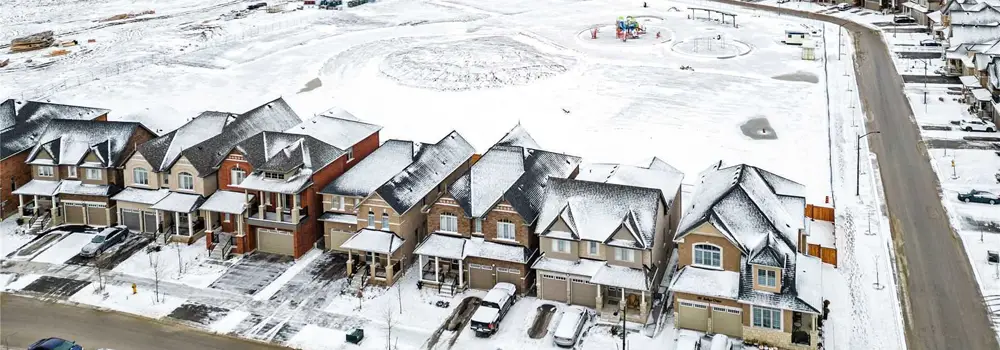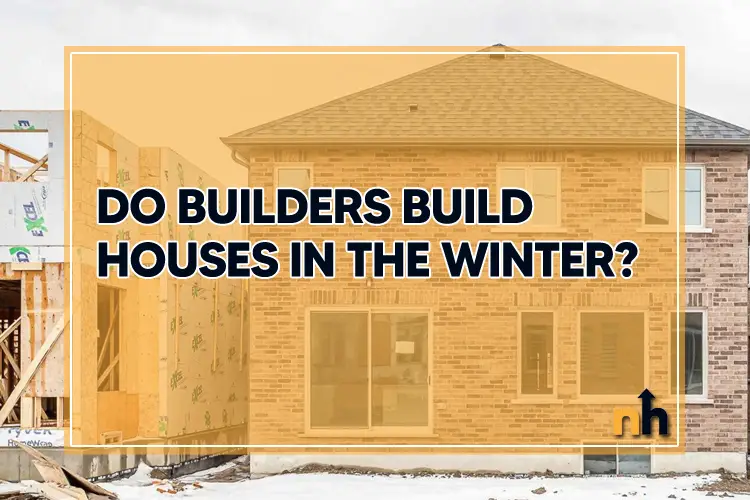Yes, homebuilders build houses in the winter and cold months. A home built in the winter uses special concrete pouring techniques to ensure the concrete cures properly in the cold. There are multiple factors builders will take into consideration when building a house in the winter, which can make winter home construction more expensive.
In Canada and the United States, some cities experience harsh cold temperatures and extreme winter conditions. However, new construction and home building is an all-year business. Homebuilders are highly experienced in winter construction, and are able to change their processes to accommodate a winter new home construction.

While the ground may be frozen in the winter, it is still possible to break ground in the winter. Excavating companies have heavy machinery that can help with breaking ground in winter weather conditions. The winter excavating process is used in many areas of Canada and United States.
Benefits of Building a House in the Winter
There are a few benefits of building a house in the winter that can benefit the homebuyer, as well as the builder in some cases. We’ll have a look at some of the notable benefits of winter construction.
Spring/Summer Move In: When you begin construction in the winter months, you are able to close on the home during the late-spring or early-summer months. It can be a seamless move for most people, as everyone is usually moving during this time. If you are selling your existing home, you don’t have to worry about finding a place in the interim.
It can also be troublesome to move during the cold and winter months, so a summer move will make things easier for buyers, movers and any post-construction contractors.
Availability of Trades: In 2023, one of the issues most builders are facing is the lack of trades and skilled-workers. Most trades are either backed-up with work, or simply not available during the summer months. However, the winter is a slow period for most construction trades, and their availability will allow for a seamless and on-time build.
Winter Discounts: With winter being a slow month for most construction projects, some builders and trade contractors tend to offer discounts and promotions. As a result, this would be a good time to take advantage of those cost savings for your new construction home.
Builder Preference: A few builders prefer building homes during milder winter conditions, because the summer months can be treacherously hot. If a new construction home build is planned out perfectly, it can begin during the fall months, and once the house is covered up by the winter – most of the interior work can take place during the cold. These homes are usually available to the buyer by early to mid-spring.

Disadvantages of Building a House in the Winter
While there were a few good reasons to building a house in the winter, we also need to consider the disadvantages of building a house in the winter. Homebuilders in Canada and the USA are experienced in building in all weather conditions, so most are ready to build all year round.
Access to the Build: With winter weather conditions, a builder’s access to the site may be limited, and will often require assistance from a snowplow. In addition, heavy snowfalls and frost-freezing can cause many areas of the home build to have limited access as well.
Wintry weather conditions can also pose some risks for the employees who are working on-site due to ice and frost on the ground. While the weather can be a problem, most builders are very familiar with these working conditions. As someone who is contracting the work out, you will need to understand the conditions in place for the homebuilders.
On-Site Conditions and Requirements: When it comes to preparing the build during winter conditions, the builder needs to use proper processes and materials to cover various sections of the build. For example, the straws and foundation need to be covered during snowstorms to prevent any issues in the build.
Additionally, making sure there is sufficient heating available on the job site will be a requirement for the builder. OSB and wood framing can get wet during heavy rainfall, and builders will use strong humidifiers to remove the humidity from the wood framing. These additional requirements are part of the winter home-building process.
Extended Timeline: During winter months, most new construction homes will experience some sort of delay in the build. This is primarily due to harsh winter weather conditions posed by snow and ice. If the builder is unable to stay on course, it can push the completion date of the home.
If you are building a house in the winter, you must prepare for potential delays in the construction timeline. If there are other factors contingent on the timeline – you need to prepare backup solutions. For example, if you are planning on having post-closing work done to the home – you will need to correctly map out those timelines and agreements.
Additional Costs: A notable disadvantage of building a house in the winter is the additional cost associated with many areas of the build. To begin, there is an increased cost for the foundation. Due to the colder temperature, the pouring of the foundation uses a specialized mix and technique. On average, a winter concrete foundation pour can cost 10% to 15% more than during the rest of the year.
When we had a quote for a recent foundation pour in the winter, this is what was quoted by our contractor:
- A brand new concrete foundation for a porch was quoted during the summer month as $35,000.
- The same concrete foundation poured between November and April was quoted $38,850 due to winter handling of the foundation.
- If additional wrapping, tarps and equipment was required, the quote for a winter installation went up to $40,250.
As you can see winter construction can definitely increase costs for foundations, covers, heating, etc. If you are prepared to take on the additional costs, the builders are always ready to take on the job. It’s important to consider all the costs of a new build home before you decide to take action.
